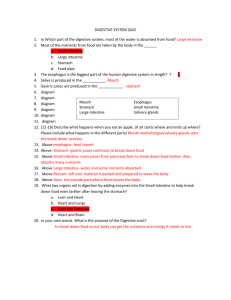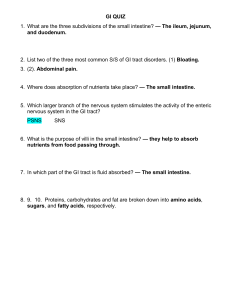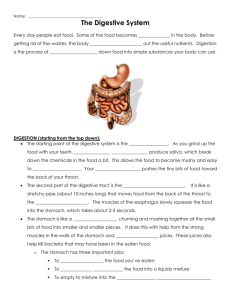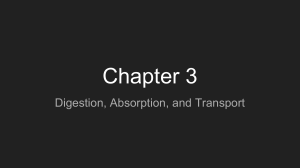Digestive System Guided Notes
advertisement
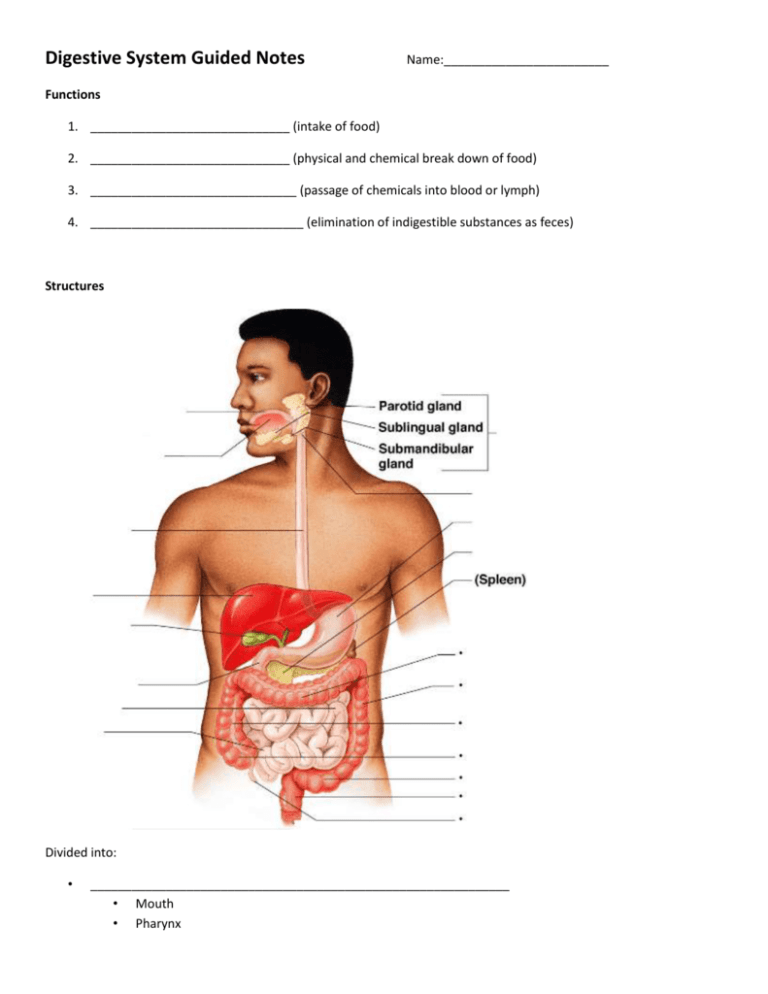
Digestive System Guided Notes Name:________________________ Functions 1. _____________________________ (intake of food) 2. _____________________________ (physical and chemical break down of food) 3. ______________________________ (passage of chemicals into blood or lymph) 4. _______________________________ (elimination of indigestible substances as feces) Structures Divided into: • _____________________________________________________________ • Mouth • Pharynx • • Esophagus • Stomach • Small intestine • Large intestine • Rectum _______________________________________________________________ • Teeth • Tongue • Gallbladder • Salivary glands • Pancreas • liver Digestive Organ Functions 1. ________________________________________ • • ______________________ mechanically digest food _________________________ • cleans mouth (contains many antimicrobial chemicals) • chemically digests food (the enzyme amylase breaks down starch into sugar) • ______________________ repositions food and helps form a __________________that can be swallowed 2. __________________________________• Passage for food, water, and air 3. _________________________________________ • Passage to stomach for food and water only • ____________________________________________ is composed of muscles at the lower end of espophagus that prevent stomach contents and acids from traveling back up the esophagus. Food is moved through the GI tract by __________________________ – ______________________________ & __________________________________ in the walls of the GI tract 4. _____________________________ • _____________________________________ food by churning and mixing it, to form ____________________. • _________________________________ food by releasing extremely acidic gastric juice which contains HCl and proteases, such as pepsin, that __________________________________ into amino acids • _________________________________________ (alcohol, aspirin, other drugs) 5. ____________________________________ • ___________________________is completed here • Sm. intestine produces _____________________________, which is alkaline and contains some digestive enzymes ____________________ is produced by the liver, stored by the gall bladder, and is dumped into the small intestine. It digests fats. Pancreas releases _________________________________into the small intestine. Include proteases, lipases, amylase, and nucleases. ________________________________________ Digested carbohydrates, fats, proteins, nucleic acids, vitamins, electrolytes, and some water absorbed 6. _______________________________________________________ • Absorption of water, electrolytes, and some vitamins • Everything not absorbed is expelled by rectum as feces Absorption Absorption occurs when nutrients pass out of the alimentary canal and into the blood capillaries (water-soluble nutrients) or lymph lacteal (fat-soluble nutrients). Some nutrients are absorbed through diffusion, but many require active transport. The small intestine has many adaptations for absorption: • • Enormous surface area due to: long length (20 ft), folds, and numerous villi & microvilli SLOOOW movement of chyme (3-6 hours) Review What is digestion, and in which structures does it occur? How does the process of digestion differ for different foods? What is absorption, and in which structures does it occur?

